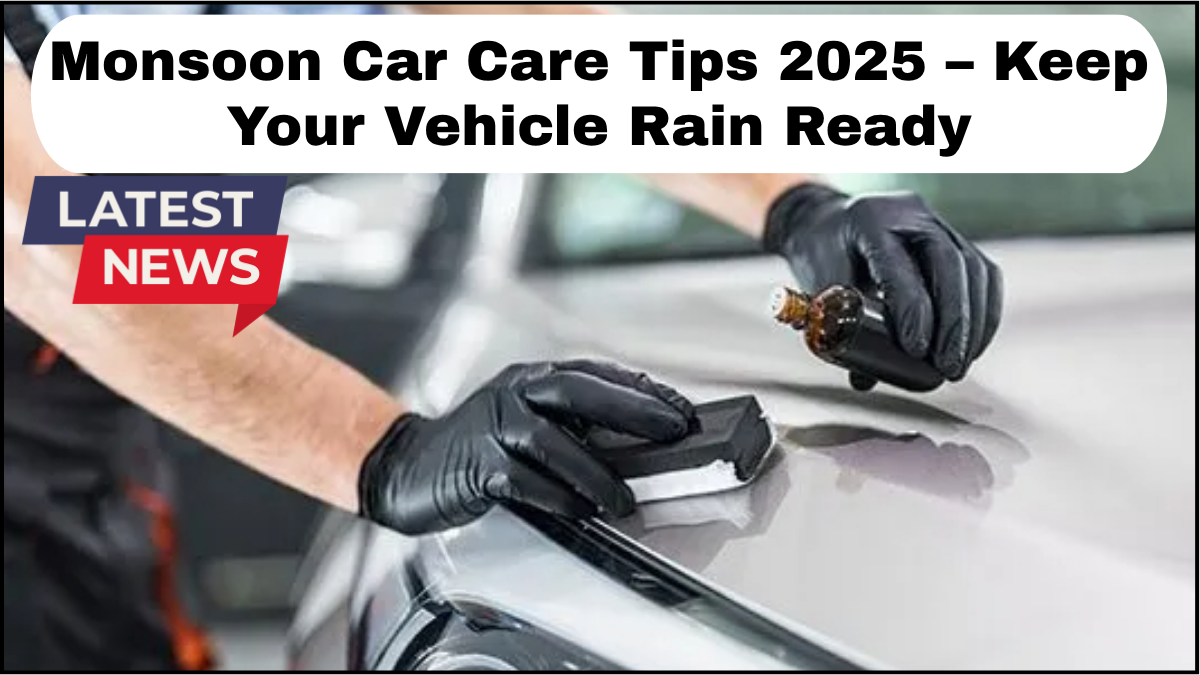The arrival of monsoon brings relief from the scorching heat, but it also presents unique challenges for car owners. Waterlogged roads, reduced visibility, and excess moisture can quickly turn a smooth drive into a frustrating or even dangerous experience. That’s why Monsoon Car Care 2025 isn’t just a seasonal suggestion—it’s a necessary part of responsible vehicle ownership.

Here’s a detailed guide to help you prepare your car for the rainy season and ensure top-notch rainy season maintenance that keeps your vehicle safe, reliable, and rain-ready.
Inspect and Replace Wiper Blades
Wipers are your first line of defense against rain-blurred windshields. In the monsoon, visibility is everything.
-
Check for cracks or brittleness: Over time, rubber wiper blades harden and crack. If your blades leave streaks or make squeaking noises, replace them immediately.
-
Don’t delay replacements: Ideally, wipers should be changed once a year—do it before the first rain hits.
-
Top up washer fluid: Fill it with a cleaning solution that helps dissolve grime and road film.
Ensure Tyre Health and Tread Depth
Worn-out tyres on wet roads are a recipe for disaster.
-
Minimum tread depth: Check that your tyres have at least 2.5mm of tread. Anything less reduces grip and increases the risk of hydroplaning.
-
Tyre pressure: During the monsoon, it’s best to keep tyres inflated slightly below the recommended PSI to increase road grip.
-
Look for uneven wear: Misalignment or suspension issues can cause patchy wear—get it checked and fixed.
Test and Protect the Electrical System
Rain and electricity don’t mix well. Preventive measures go a long way.
-
Battery inspection: Check terminals for corrosion and ensure secure connections. A weak battery is more likely to fail in humid conditions.
-
Check lighting systems: Make sure all headlights, brake lights, and indicators are functioning properly. Fog lights are also a must during heavy rain or low visibility.
-
Seal connectors: Use dielectric grease or insulation tape to cover exposed wires and prevent short circuits.
Underbody Anti-Rust Coating
Excess moisture leads to rust—especially on the car’s underside.
-
Get an anti-rust coating: This protective layer shields your car’s underbody from moisture and salt present in rainwater.
-
Re-coat if needed: If your car already has a coating from a previous season, get it inspected for wear and touch-ups.
Clean and Seal Door Rubbers and Windows
Water seeping into the cabin can be more than just annoying—it leads to mold and electrical damage.
-
Lubricate rubber beadings: Use silicone-based lubricants to keep door and window seals soft and effective.
-
Replace worn seals: If the rubber is cracked or stiff, replace it immediately.
-
Ensure window channel drainage is clear: Clogged channels can lead to water trickling inside when it rains.
Monitor Brake Performance
Brakes behave differently in wet weather, often requiring longer stopping distances.
-
Check brake pads and discs: Wet conditions wear down brakes faster. Listen for any screeching sounds or reduced bite.
-
Dry the brakes occasionally: After driving through a puddle, lightly press the brake pedal to dry the rotors.
-
Inspect ABS and traction control systems: These systems help you maintain control in slippery conditions—don’t ignore warning lights.
Maintain a Clean and Fog-Free Cabin
Interior care is just as important for overall monsoon car care.
-
Use all-weather floor mats: Rubber mats are easy to clean and prevent water from soaking into the carpet.
-
Use a moisture absorber or dehumidifier: This prevents window fogging and controls cabin humidity.
-
Defog correctly: Use the AC in ‘fresh air mode’ to clear windshields quickly and efficiently.
Stay Stocked with Emergency Essentials
Preparation can save you in a pinch.
-
Carry a flashlight, raincoat, towel, and basic toolkit.
-
Keep jumper cables and a portable air compressor handy.
-
Store important vehicle documents in waterproof covers.
Final Thoughts
Monsoon Car Care 2025 isn’t just about vehicle longevity—it’s about safety, reliability, and peace of mind. By staying proactive and checking all the key areas mentioned above, you can drive through the rains confidently, while minimizing breakdown risks and costly repairs.
Frequently Asked Questions (FAQ)
1. Why is Monsoon Car Care important?
Monsoon car care ensures your vehicle functions safely and efficiently during rainy conditions, preventing breakdowns, water damage, and accidents.
2. How often should I check tyre pressure during the monsoon?
Check tyre pressure every two weeks. Rainy roads demand optimal traction, and pressure fluctuations are common due to temperature and moisture.
3. Can rainwater damage my car battery?
Yes. Prolonged exposure to moisture can corrode battery terminals and connectors, leading to short circuits and startup failures.
4. Should I wash my car during the rainy season?
Absolutely. Regular washing removes acidic rainwater and dirt that can damage the paint and lead to rust, especially in hard-to-reach spots.
5. What’s the best way to defog windows in the rain?
Use your car’s air conditioning in fresh air mode, or direct the airflow toward the windshield using the defogger setting. Keep the cabin dry to reduce humidity.
click here to learn more
